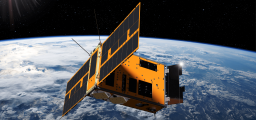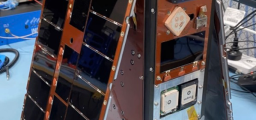Posted by: Marco Citossi
HERMES Pathfinder on its way to orbit: successful launch!
Today, March 15, 2025 (7:39 CET), the HERMES Pathfinder mission was successfully launched from Vandenberg Space Force Base, California, aboard SpaceX’s Falcon 9 rocket, as part of the Transporter-13 mission.
The HERMES constellation, composed of six 3U CubeSat nanosatellites, was delivered into a Sun-synchronous orbit at approximately 510 km altitude, as planned in the mission profile. Over the coming days, the satellites will be gradually released into orbit from D-Orbit’s ION Satellite Carrier platform, with one satellite deployed per day.
HERMES Pathfinder is an international project led by Italy, coordinated by INAF (Istituto Nazionale di Astrofisica) and the Italian Space Agency (ASI), involving numerous research institutions and universities:
🔹 INAF – National Institute for Astrophysics
🔹 ASI – Italian Space Agency
🔹 Politecnico di Milano
🔹 University of Pavia
🔹 UniCa – University of Cagliari
🔹 Fondazione Bruno Kessler
🔹 INFN – National Institute for Nuclear Physics
🔹 Eberhard Karls Universität Tübingen
🔹 University of Udine
🔹 Institute of High Energy Physics (IHEP), CAS, China
Additional partners of the HERMES Scientific Pathfinder project include: FPM, Skylabs, University of Nova Gorica, Aalta-lab, ELTE, C3S, Masaryk University, Konkoly Observatory, and DEIMOS.
The HERMES Pathfinder mission aims to probe the temporal variability of X-ray radiation emitted by high-energy cosmic transients, such as Gamma-Ray Bursts (GRBs) and electromagnetic counterparts of Gravitational Wave Events (GWEs). Thanks to a new generation of miniaturized detectors mounted aboard a constellation of nanosatellites in Low Earth Orbit (LEO), HERMES Pathfinder will open new avenues in the study of extreme astrophysical phenomena.
Scientific coordination of the project is led by Dr. Fabrizio Fiore, Director of INAF – Astronomical Observatory of Trieste, who emphasizes:
“With HERMES Pathfinder, Italy confirms its leading role in high-energy space science. This mission demonstrates the potential of small satellite constellations for astrophysical research, opening new perspectives in the observation of the Universe and in international collaboration.”
The mission control center is managed by ALTEC in Turin, while the science operations center is located at ASI’s scientific data center. Ground support is provided by two dedicated stations: one in Italy (Spino d’Adda) and one in Australia (Katherine), operated by an international consortium funded by the EC project AHEAD2020, comprising INAF as well as the University of Tasmania, the University of Melbourne, and Masaryk University.




